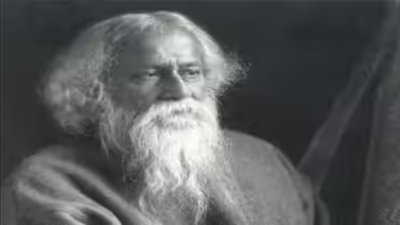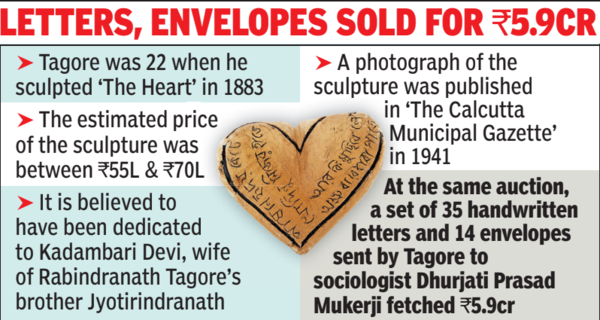ARTICLE AD BOX

Rabindranath Tagore's only known sculpture, ‘The Heart,’ believed to be dedicated to Kadambari Devi, fetched over ₹1 crore at a Kolkata auction. A set of 35 letters from Tagore to sociologist Dhurjati Prasad Mukerji sold for ₹5.9 crore. Created in 1883, ‘The Heart’ features a poignant Bengali inscription.
KOLKATA: ‘The Heart’, the only known sculptural piece attributed to Rabindranath Tagore, was sold for Rs 1,04,52,210 at an auction in the city on Friday. Its estimated price was between Rs 55 lakh and Rs 70 lakh.
According to auction house AstaGuru’s ‘Collectors’ Choice’, the sculpture is believed to have been dedicated to Kadambari Devi, wife of his brother Jyotirindranath.At the same auction, a set of 35 handwritten letters and 14 envelopes sent by Tagore to sociologist Dhurjati Prasad Mukerji between 1927 and 1936, fetched Rs 5.9 crore. The estimated bidding price of the set was between Rs 5 crore and Rs 7 crore.Tagore was only 22 when he sculpted ‘The Heart’ in 1883 during a contemplative retreat in the coastal town of Karwar in Karnataka in the company of his brother Satyendranath and sister-in-law Jnanadanandini Devi. On it, he engraved in Bengali — ‘Having cut my heart of stone,I have engraved (the words) with my own hand. Will it ever be effaced by the flow of tears?’

In 1941, a photograph of the sculpture was published in ‘The Calcutta Municipal Gazette’.
The caption mentioned it as a “piece of quartzite stone cut in the form of a heart by the poet’s own hands and the verse composed and engraved by him... It was presented to his friend, the poet Akshoychandra”. Akshoychandra Chowdhury was a classmate of Jyotirindranath. “This emotionally charged and deeply personal object not only expands the understanding of Tagore’s artistic practice but also offers a rare glimpse into his inner world during a formative period.
Preserved in a russet pouch, this intimate object reveals a lesser-known dimension of the Nobel laureate’s creative life: a brief foray into sculpture infused with emotional vulnerability. Seen by many as a gesture of unrequited love, the sculpture transforms inner grief into form—bearing the emotional weight of a young Tagore’s private longing, etched forever in stone,” said Manoj Mansukhani, CMO, AstaGuru Auction House.Akshoychandra passed on the piece to his daughter, Umarani, who subsequently gave it to her daughter, Debjani. Painter Atul Bose was married to Debjani, and the piece was in their care until its re-emergence for public appreciation when it was exhibited in Kolkata in 2024.“Any piece by Tagore, be it a sculpture or a letter, is priceless. It does not surprise me that they fetched a high value. Though it is completely the prerogative of the owner to decide where they want to keep it, I would personally love to see them in museums where the public has a chance to view them.
People should be able to read letters written by Tagore or see a piece sculpted by him. Though I belong to the family, I believe Tagore belongs to humanity,” said Sumanto Chattopadhyay, great-great-grandson of Satyendranath Tagore.The letters that Tagore sent to sociologist Mukerji offer deep insight into the poet’s creative evolution, philosophical reflections, and transition from literary to visual expression. “The result is especially significant considering the lot was not a visual artwork but a manuscript-based archive and yet became the second-highest price ever achieved for a Rabindranath Tagore creation at auction,” Mansukhani said.



.png)
.png)
.png)
















 4 hours ago
4
4 hours ago
4









 English (US) ·
English (US) ·